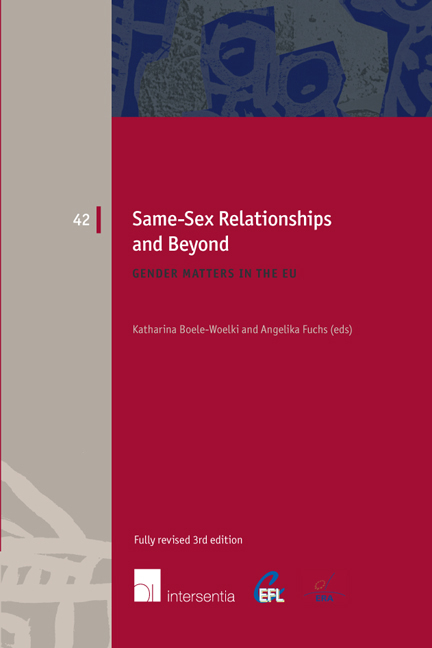Book contents
- Frontmatter
- Preface
- Contents
- List of Authors
- Part I Formalising a Same-Sex Relationship: Marriage and Partnership
- Northern Europe: Same-Sex Relationships and Family Law
- Legal Recognition of Same-Sex Relationships in Central Europe: Steady Progress
- Southern Jurisdictions: Consolidation in the West, Progress in the East
- Same-Sex Partnerships in Eastern Europe: Marriage, Registration or No Regulation?
- Part II Parenthood and Children's Rights
- Part III Gender Identity and Human Rights
- EUROPEAN FAMILY LAW SERIES
Northern Europe: Same-Sex Relationships and Family Law
from Part I - Formalising a Same-Sex Relationship: Marriage and Partnership
Published online by Cambridge University Press: 29 September 2018
- Frontmatter
- Preface
- Contents
- List of Authors
- Part I Formalising a Same-Sex Relationship: Marriage and Partnership
- Northern Europe: Same-Sex Relationships and Family Law
- Legal Recognition of Same-Sex Relationships in Central Europe: Steady Progress
- Southern Jurisdictions: Consolidation in the West, Progress in the East
- Same-Sex Partnerships in Eastern Europe: Marriage, Registration or No Regulation?
- Part II Parenthood and Children's Rights
- Part III Gender Identity and Human Rights
- EUROPEAN FAMILY LAW SERIES
Summary
INTRODUCTION
In 2012, I described the legal situation of same-sex relationships in the Nordic countries particularly concerning the way that the development in these countries had taken the same direction, although the tempo had differed. At that time, the legal positions in Norway, Sweden and Iceland were very similar, as these three countries had introduced gender-neutral marriage in 2008, 2009 and 2010, respectively. Today, Denmark and Finland have followed the other Nordic countries by introducing laws on marriage for same-sex couples in 2012 and 2015 respectively.
Since Denmark introduced an Act on Registered Partnership in 1989, similar acts have been adopted in the other Nordic countries allowing two people of the same sex to enter into a registered partnership. As a consequence of the new rules on gender-neutral marriage, it is no longer possible to establish a new partnership under the old Act on Registered Partnership. Thus, a registered partnership in the Nordic countries was a temporary legal solution. A previously registered partnership may be converted into a marriage upon the partners ‘ request. A partnership that is not converted into a marriage remains in force. The laws relating to the legal situation of same-sex partners are an excellent example of the long tradition for trying to harmonise family law throughout the Nordic region. The Nordic cooperation is based on two factors: (a) a common culture, religion and social structures that go back many hundreds of years; and (b) the Scandinavian languages that have great similarities.
This chapter focuses mainly on the past four years, showing that although the legal situation in the five Nordic countries is very similar for same-sex couples who want their partnership formalised, there are still differences in the detail as well as in the more central issues. Furthermore, there are major differences for those couples who do not marry, as there are only special family law legislations on cohabitation in Sweden, Norway and Finland, and these acts are very different. The chapter ends with presenting principles for the regulation of the financial circumstances of cohabitants which are described in the book Nordic Cohabitation Law from 2015.
- Type
- Chapter
- Information
- Same-Sex Relationships and BeyondGender Matters in the EU, pp. 3 - 18Publisher: IntersentiaPrint publication year: 2017
- 1
- Cited by

